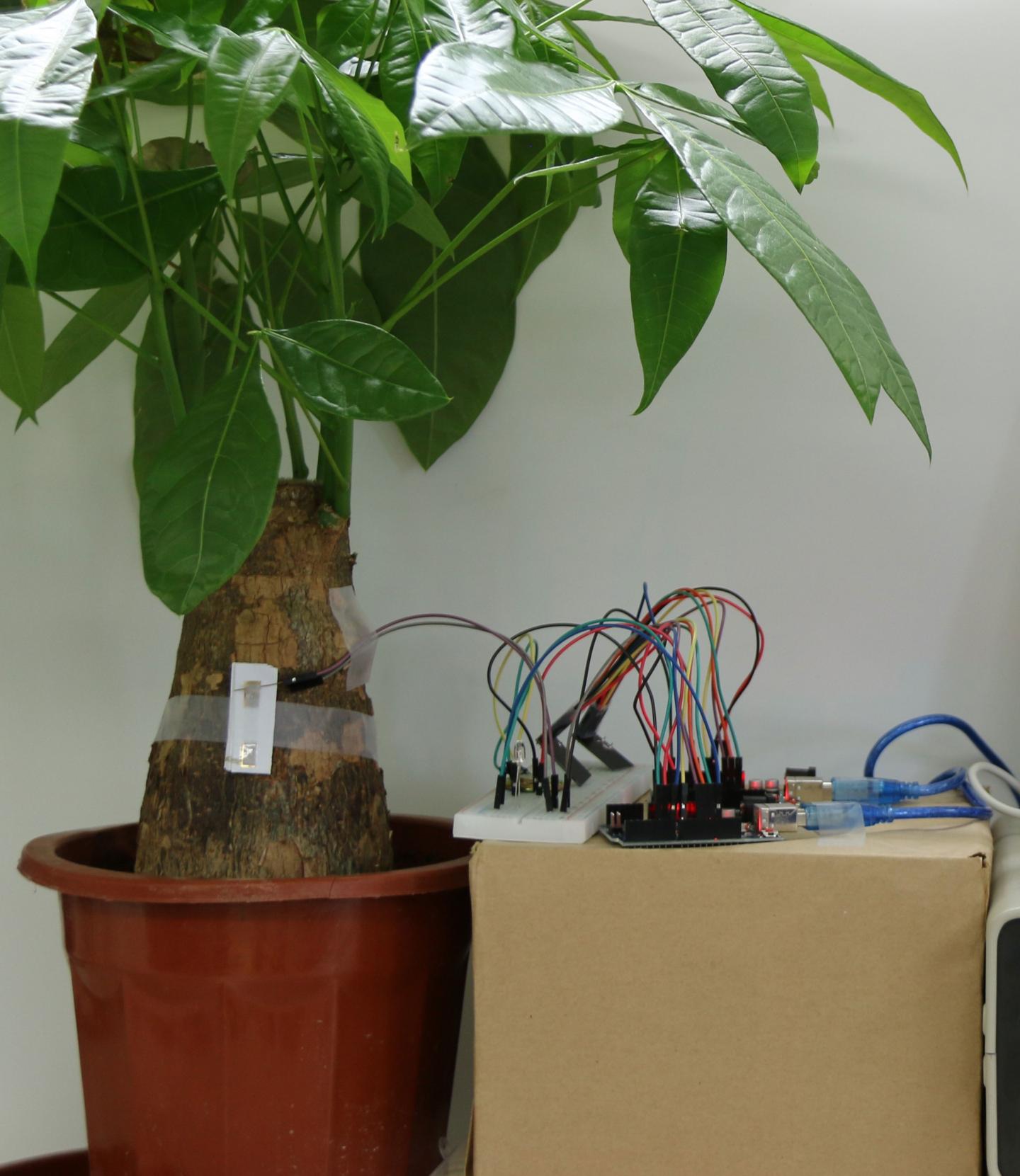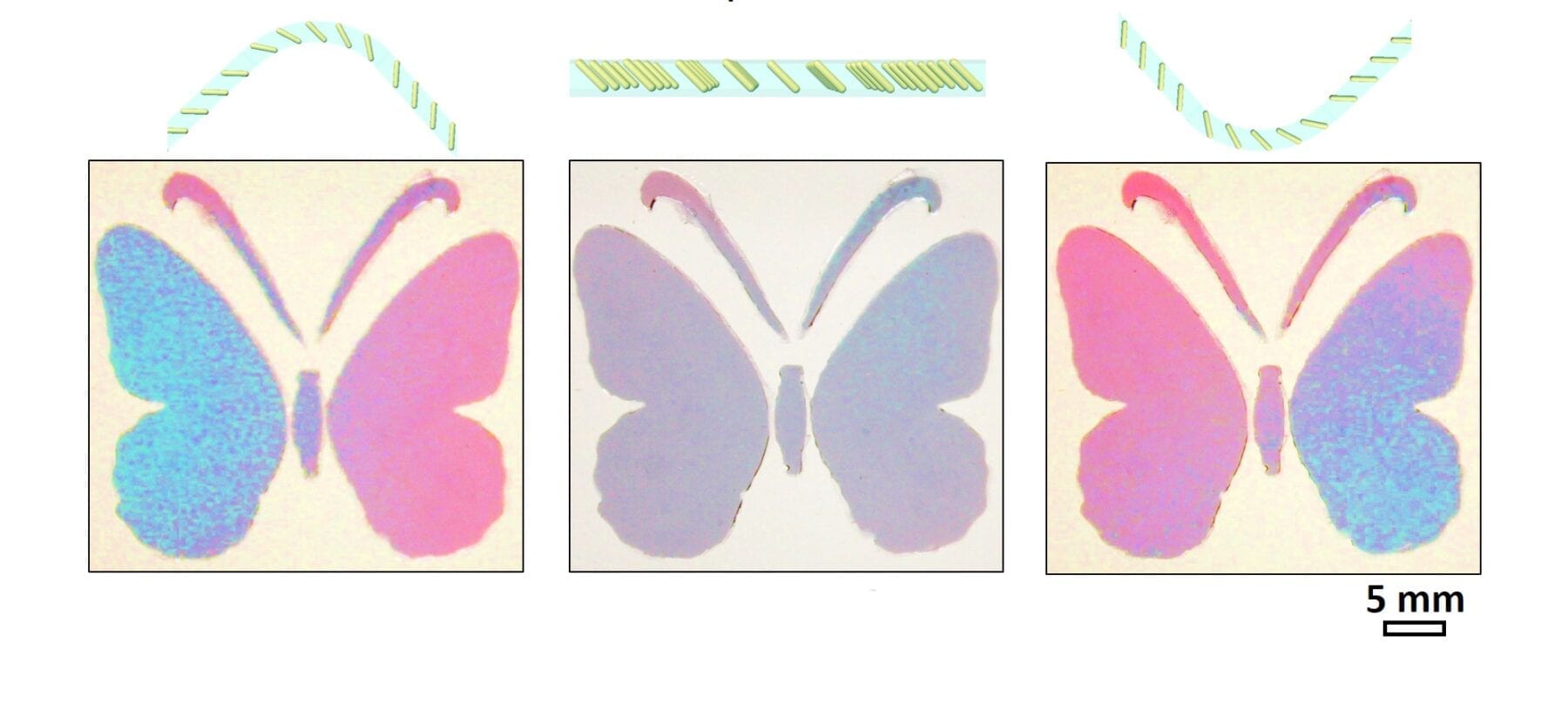
A sensor (white strip) on a houseplant activates an alarm when fire is near.
Credit: Adapted from ACS Applied Materials & Interfaces 2020, DOI: 10.1021/acsami.0c04798
“Self-Powered and Green Ionic-Type Thermoelectric Paper Chips for Early Fire Alarming”
Recent devastating fires in the Amazon rain forest and the Australian bush highlight the need to detect forest fires at early stages, before they blaze out of control. Current methods include infrared imaging satellites, remote sensing, watchtowers and aerial patrols, but by the time they sound the alarm, it could be too late. Now, researchers reporting in ACS Applied Materials & Interfaces have developed self-powered “paper chips” that sense early fires and relay a signal.
Previously, scientists have proposed placing a network of sensors in the forest that could detect changes in temperature, smoke or humidity and wirelessly transmit a signal to responders. However, such a system hasn’t yet seemed practical because all of the sensing components require power. Batteries would eventually go dead and need to be replaced. Thermoelectric materials, which convert temperature differences into electricity, could simultaneously detect temperature increases from fires and power themselves. However, most of these materials are solid inorganic semiconductors, which are often expensive, rigid and environmentally unfriendly. Yapei Wang and colleagues wanted to find out if ionic liquids could be used as thermoelectric materials for fire sensing. These fluids are salts in the liquid state, and two different types of ionic liquids can be connected in series to generate signals.
To make paper-based thermoelectric sensors, the researchers chose two ionic liquids that behaved differently when the temperature increased: One adsorbed to the surface of gold electrodes, while the other desorbed, producing opposite (positive or negative) voltages. They deposited each ionic liquid like an ink between two gold electrodes that were sputtered onto a piece of ordinary paper. When connected in series, the two ionic liquids produced an electric signal when a large temperature difference occurred, as would happen in a fire. In a pilot test of the new sensor, the researchers attached one to a houseplant. When they placed a flaming cotton ball close to the plant’s roots, the temperature at the bottom of the sensor quickly increased, producing a voltage signal that an attached microcomputer chip wirelessly transmitted to a receiver. Upon picking up the signal, the receiver activated a sound alarm and a red light. The thermoelectric paper chips are cheap ($0.04), and the materials are eco-friendly, the researchers say.
The Latest Updates from Bing News & Google News
Go deeper with Bing News on:
Thermoelectric paper chips
- Nasa engineers bring Voyager 1 back to life after interstellar glitch
After a sudden loss of contact in November, mission controllers were able to reestablish contact with the probe across 15bn miles of space ...
- Awesome Travel Trailer Remodel Ideas [Video Included!]
I liked the way it looked but quickly found I needed to add a paper plate to the bottom of the basket so the fruit didn’t get dented! I did love how the kids could just grab a piece of fruit when they ...
Go deeper with Google Headlines on:
Thermoelectric paper chips
[google_news title=”” keyword=”thermoelectric paper chips” num_posts=”5″ blurb_length=”0″ show_thumb=”left”]
Go deeper with Bing News on:
Forest fire detection sensors
- Odisha: Forest department to deploy ODRAF units in sensitive divisions to fight wildfire
BHUBANESWAR: As the intense heatwave has triggered a rapid spike in forest fire incidents across the state, the government has decided to deploy ODRAF units in ...
- Forest fire at Yercaud
A forest fire broke out at Ladies Seat in Yercaud on Wednesday. Fire began emanating from the forest near the Ladies Seat locality in Yercaud on Wednesday. Tourists were asked to leave the area ...
- Forest Hill apartment fire starts with microwave
A microwave fire in a Forest Hill apartment Wednesday caused ... A neighbor heard a smoke alarm and later discovered someone inside the apartment, which had heavy smoke, the release said.
- Fight fire with fire: Forest appeal against points deduction
As expected, Nottingham Forest is going to appeal the points deduction that subtracted four points from the club’s Premier League point total. The English top flight ruled that Forest violated the ...
- Forest River, Inc. - LED Backlight Circuit Board Failure May Cause Fire
Forest River, Inc. (Forest River) is recalling certain 2021-2022 Forest River Cardinal, Wildcat, 2018-2019 Cedar Creek, 2021 Columbus, 2023 Continental Cargo, 2021-2024 Dynamax DX3, Dynamax ...
Go deeper with Google Headlines on:
Forest fire detection sensors
[google_news title=”” keyword=”forest fire detection sensors” num_posts=”5″ blurb_length=”0″ show_thumb=”left”]










